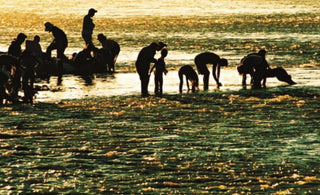
There are many celebrations in Tibet demonstrating how colorful the culture and tradition is in Tibet. One of the most captivating and revered events in Tibetan tradition is the annual Bathing Week, a significant celebration that transcends mere cleansing rituals. This profound ceremony holds deep spiritual, cultural, and historical significance, representing a convergence of faith, tradition, and community.
The Essence of Bathing Week
During the annual Bathing Week, Tibetans immerse themselves in the age-old practice of cleansing body and soul. It's a celebration where individuals engage in spiritual purification rituals: symbolizing the washing away of sins, ailments, and negative influences. This week-long event is rooted in Buddhist beliefs, emphasizing the importance of purity in both body and mind.
The Spiritual Significance
At the heart of this tradition lies a profound spiritual significance. The act of cleansing holds symbolic meaning, representing the purification of one's karma and the attainment of spiritual cleansing. Participants believe that during this auspicious time, water becomes spiritually charged, offering healing properties that cleanse the spirit and bring blessings for the year ahead. By immersing themselves in these sacred practices, participants seek not only purification but also spiritual nourishment and protection. They believe that these blessings garnered during Bathing Week will guide them through the year, offering divine guidance and safeguarding against adversities.
Every action during Bathing Week carries profound symbolism. The act of washing Buddha statues, thangkas, and scriptures with consecrated water symbolizes more than just a physical cleaning. It signifies the renewal of one's spiritual commitment, the washing away of past transgressions, and the accumulation of positive merit and blessings. It's believed that this merit contributes to one's spiritual growth, bringing individuals closer to enlightenment and liberation from the cycle of rebirth. Participants engage in self-examination, seeking to rid themselves of negative thoughts, emotions, and habits. This period provides an opportunity for individuals to introspect, reevaluate their spiritual journey, and set intentions for personal growth and enlightenment.
Apart from benefits looked for individuals, this festival also reaches far beyond and fosters communal spirituality. Communities come together, fostering a sense of communal spirituality. The collective prayers, offerings, and acts of generosity during this time serve to strengthen the spiritual bond among the community members. It's a time when the collective energy of faith and devotion amplifies, creating a shared spiritual atmosphere that resonates throughout the community.
The Rituals and Practices of the Bathing week
Throughout Bathing Week, Tibetans visit sacred sites, including temples, monasteries, and natural springs. They perform elaborate rituals involving the symbolic act of washing Buddha statues, thangkas, and scriptures with consecrated water. This act is believed to accumulate merit and blessings, fostering spiritual growth and well-being.
The Historical Context
The origins of Bathing Week can be traced back to the Tibetan King Songtsen Gampo in the 7th century. Legend has it that the king, after marrying Chinese and Nepalese princesses, who were fervent Buddhists, initiated the integration of Buddhism into Tibetan society. As part of this cultural exchange, he introduced various Buddhist rituals and practices, including the establishment of temples and the adoption of Buddhist scriptures. Among these practices was the annual observance of what is now known as Bathing Week. The origins of this tradition lie in the king's commitment to embracing Buddhist principles and rituals, aiming to foster spiritual growth and cultural enrichment among the Tibetan populace.
The historical significance of Bathing Week transcends mere ritualistic observance; it represents a vibrant tapestry of Tibetan history, spirituality, and cultural evolution. It serves as a bridge between the past and the present, carrying forward the legacy of King Songtsen Gampo's visionary efforts to merge Buddhist principles with indigenous Tibetan customs.
Over the centuries, this practice has evolved, amalgamating various elements of Buddhist philosophy and indigenous Tibetan customs.
Evolution of Tradition
Though rooted in Buddhist beliefs, Bathing Week also reflects the syncretism present in Tibetan culture. It intertwines elements of Buddhism with indigenous practices, embodying a harmonious blend of religious and cultural traditions.
Cultural Importance
Bathing Week serves as a testament to the resilience of Tibetan culture and its unwavering commitment to preserving traditions despite historical challenges. It stands as a celebration of cultural identity and serves as a reminder of the significance of cultural heritage.
Throughout history, Tibet has faced numerous challenges, including political upheavals and cultural suppression. However, amidst these trials, the traditions associated with Bathing Week have persevered as a symbol of cultural resilience. The preservation of this tradition reflects the resilience of a people determined to safeguard their identity and cultural legacy.
This annual celebration also serves as a unifying force within Tibetan communities. Regardless of geographical distances or diverse backgrounds, Bathing Week brings individuals together in shared observance and reverence. It creates a sense of unity, fostering connections among Tibetans dispersed across different regions.
Beyond its local significance, Bathing Week has garnered global attention and appreciation. Its cultural richness and profound symbolism have attracted enthusiasts, scholars, and admirers from around the world, fostering cross-cultural understanding and appreciation.
Conclusion: Oriental Aesthetics and Cultural Exploration
At Oriental Aesthetics, we are passionate about fostering a deeper understanding and appreciation for classical oriental art and culture. Our commitment extends beyond mere observation; we aim to bridge cultures, enabling enthusiasts, collectors, and artists to immerse themselves in the rich tapestry of oriental traditions. Through our systematic and high-quality professional services, we invite individuals to explore, appreciate, and cherish the depth and beauty of oriental traditions.
























